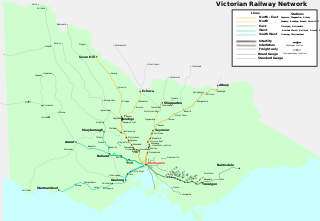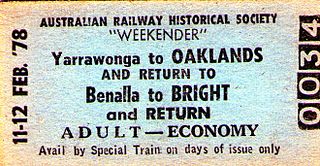Related Research Articles

Rail transport in the Australian state of Victoria is provided by a number of railway operators who operate over the government-owned railway lines. The network consists of 2,357 km of Victorian broad gauge lines, and 1,912 km of standard gauge freight and interstate lines; the latter increasing with gauge conversion of the former. Historically, a few experimental 762 mm gauge lines were built, along with various private logging, mining and industrial railways. The rail network radiates from the state capital, Melbourne, with main interstate links to Sydney and to Adelaide, as well as major lines running to regional centres, upgraded as part of the Regional Fast Rail project.

Yarrawonga is a town in the Shire of Moira local government area in the Australian state of Victoria. The town is situated on the south bank of the Murray River, the border between Victoria and New South Wales, and is located approximately 265 kilometres (165 mi) north-east of the state capital, Melbourne. Yarrawonga's twin town of Mulwala is on the other side of the Murray River. At the 2016 census, Yarrawonga had a population of 7,930.

Benalla railway station is located on the North East line in Victoria, Australia. It serves the town of Benalla, and it opened on 18 August 1873.
The North East railway line is a railway line in Victoria, Australia. The line runs from Southern Cross railway station on the western edge of the Melbourne central business district to Albury railway station in the border settlement of Albury-Wodonga, serving the cities of Wangaratta and Seymour, and smaller towns in northeastern Victoria.
The Tocumwal railway line is a 1,600 mm gauge railway line in Victoria, Australia. The line runs between the border town of Tocumwal in New South Wales to Southern Cross, Melbourne. The line is utilised by various passenger and freight trains serving the northern suburbs of Melbourne and northern regions of Victoria.

The Katamatite Football Netball Club, nicknamed the Tigers, is an Australian rules football and netball club based in the small Victorian town of Katamatite.
The Dookie United Football Netball Club, known as the "Dooks", is an Australian rules football and netball club playing in the Kyabram District Football Netball League. Dookie United is based in the small Victorian town of Dookie.

The County of Moira is one of the 37 counties of Victoria which are part of the cadastral divisions of Australia, used for land titles. It is located to the east of the Goulburn River, south of the Murray River, and west of part of the Ovens River. Part of Wangaratta is in the county, on the eastern end of it. It also includes Shepparton. The Shire of Moira is in a similar area.

The N Class are a class of diesel locomotives built by Clyde Engineering in Somerton for V/Line between 1985 and 1987.

The Shire of Shepparton was a local government area in the Goulburn Valley region, about 180 kilometres (112 mi) north of Melbourne, the state capital of Victoria, Australia. The shire covered an area of 927.49 square kilometres (358.1 sq mi), and existed from 1884 until 1994. From 1927 onwards, Shepparton itself was managed by a separate entity, ultimately known as the City of Shepparton.

The Shire of Tungamah was a local government area in the Goulburn Valley region, about 240 kilometres (149 mi) northeast of Melbourne, the state capital of Victoria, Australia. The shire covered an area of 1,143 square kilometres (441.3 sq mi), and existed from 1878 until 1994.

The Oaklands railway line is a freight-only railway line in north-eastern Victoria, Australia. The line branches from the main North East railway at Benalla station and runs across the Victoria-New South Wales border to the town of Oaklands, New South Wales.
The Noojee railway line is a closed railway line in Victoria, Australia. Branching off from the Gippsland line at Warragul station, it was built to service the timber industry in the upper Latrobe River area, transporting timber as well as providing a general goods and passenger service to townships in the area. The final section of the line between Neerim South and Noojee traversed increasingly hilly terrain and featured a number of large timber trestle bridges. Extensively and repeatedly damaged by bushfires over the years, the line was closed in the 1950s and dismantled. The last remaining large trestle bridge on the line has been preserved and has become a popular local tourist attraction.

Youanmite is a locality in the Shire of Moira. It is located near the intersection of Youanmite and Katamatite roads, approximately 25 km southwest of Yarrawonga and approximately 200 km northeast of Melbourne, Australia. Youanmite was once a small town having its own schools, churches, and post office. Comprising medium to large farms the area is predominantly agricultural, focusing on grain production as well as sheep and cattle grazing.
Muckatah is a locality in northern Victoria, Australia in the local government area of the Shire of Moira.

Yabba North is a locality in northern Victoria, Australia. The locality is the Shire of Moira local government area. At the 2011 census, Yabba North and the surrounding area had a population of 256.
The St. James Football Club was an Australian rules football club based in St. James, in North East Victoria, Australia, and was formed in May 1883.
The Cobram railway line was a short branch of the Tocumwal line in the north-eastern region of the Victorian railway network.
The Benalla Tungamah Football League (TBFL) was established in May, 1938, from the following North Eastern Victoria, Australian rules football clubs – Benalla, Devenish, Katamatite, St. James, Tungamah and Yabba – Dookie.
Victorian Railways No.1 was the first government passenger steam locomotive on Victorian Railways(VR). It was a 2-2-2 tender locomotive built in 1857 by George England & Co. with their builders number 146. It arrived at Port Phillip in September 1858 along with 4 goods locomotives of 0-6-0 tender configuration.
References
- ↑ "Tramways in Country Districts Act" (PDF). Australasian Legal Information Institute. Retrieved 26 September 2023.
- ↑ "Country Tramways". The Argus. 28 December 1886. Retrieved 5 January 2016.
- ↑ "Late Mr. T.W. Fowler". The Argus. 6 December 1928. Retrieved 5 January 2016.
- 1 2 Parliament of Victoria (December 1890). Final Report of the Select Committee in regards to Tramways constructed under Country Tramways Trust Fund.
- ↑ "The Dookie to Katamatite Railway". The Argus. 15 May 1890. Retrieved 5 January 2016.
- ↑ Oberg, Leon (1975). Locomotives of Australia. Terry Hills, Sydney: A.H. & A.W Reed. p. 17. ISBN 0589071734.
- ↑ "Closing of the Katamatite Tramway". The Argus. 10 August 1892. Retrieved 5 January 2016.
- ↑ "Katamatite". Benalla Standard. 27 January 1905. Retrieved 5 January 2016.
- ↑ "Katamatite Request". The Argus. 26 January 1912. Retrieved 5 January 2016.
- ↑ "Katamatite Railway: Proposed Extension". The Argus. 1 March 1926. Retrieved 5 January 2016.
- ↑ "New Railway Line: Proposal Rejected". The North Eastern Ensign (Benalla). 2 July 1926. Retrieved 5 January 2016.
- 1 2 3 Waugh, Andrew. "Shepparton-Katamatite" (PDF). Victorian Station Histories. Retrieved 5 January 2016.
- ↑ "Dookie Rail Trail" (PDF). Lifestyle Dookie. Archived from the original (PDF) on 27 February 2016. Retrieved 5 January 2016.
- ↑ Sexton, David (19 March 2021). "Questions posed over Dookie rail line in Victoria". Rail Express. Retrieved 26 September 2023.